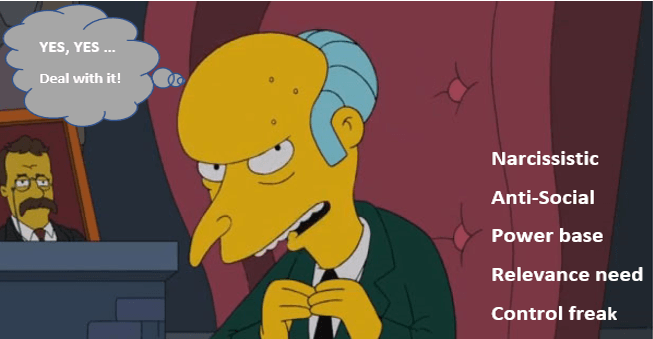The Passive Bully Boss … PART TWO – Recognising the behaviour drivers

Passive bullying … who would do that? Definitely not you, right? What drives a boss to treat employees that way?
In the previous article – The Passive Bully Boss – PART ONE – Is that your management style?, I provided an overview of what passive bullying is, particularly naming and shaming this insidious, often hidden behaviour. If you haven’t read Part ONE, may I suggest that’s a good place to start, as identifying the pattern of behaviour is step one. It may just surprise you how common some of the listed behaviours are; worth checking that they are NOT in your own management style kit.
Firstly, from my observations across various workplaces, these behaviours are mostly done with deliberate intent. The passive bully generally knows exactly what they are doing, although there have been some cases where further coaching exploration revealed it was a learned behaviour from being on the receiving end themselves, in the past. Therefore, while they were less self-aware of what they were doing, as it was more of a monkey see, monkey do habit; they were certainly conscious of the end outcome they fully intended to manipulate.
Because passive bullying is often carried out in many small, unseen actions that collectively chip away at the victim’s confidence, or gradually undermine their character, it’s much harder to prove. This means the perpetrator may continue to get away with it for years; so, they tend to become very experienced at using this tactic to get their own way, across various aspects in their life.
Their thinking becomes: ‘well, it worked – she resigned = we got rid of her … got away with it, so I’ll do it again next time’ … and the perpetrator becomes confident and cocky.
Perhaps the scariest situation I have noticed is that when they have been using this ‘style of management’ for years, they actually do believe there is nothing wrong with that. Just recently I observed a case where the HR investigator’s findings, after a very brief review, stated that the two parties simply ‘had differing management styles’. Let me reiterate – passive bullying behaviour is NOT a management style, and certainly has NO place in leadership roles.
Now, let’s look at WHY they do it. I have one of those enquiring minds that needs to know why; to make sense of these unacceptable behaviours too often observed in workplaces; the gestures and actions that make me tilt my head to one side, frown with a questioning raised eyebrow, shake my head and start digging for answers. Understanding what drives the perpetrator to behave in this way, helps to join the dots in flushing this culture destroying misconduct out of your workplace.
While there is no one type of personality who are typically passive bully bosses, a variety of researched studies confirm that the serial perpetrators often have narcissistic or anti-social personality traits, stemming from their own unresolved psychological issues, often experienced as a child. Adding to the research, here’s the specific motivating behaviours and drivers I’ve observed from workplace based passive bullies:
Narcissistic traits – no one else is more important to the narcissist than themselves. Their radar is tuned to anything or anyone that potentially may out-shine them; believing that blowing other’s candles out, makes theirs burn brighter. One alarming driver is that they love the game of getting away with it, more than the action itself. Like a cat and mouse game, they love the taunt, seeing the victim squirm, even being questioned; because the best part is convincing everyone else that others are delusional. They get off on this deception; the cleverness of getting away with it … again and again. Watch for the patterns.
Anti-social traits – a real disregard for other people’s rights, the anti-social personality feels little or no empathy toward other people and tends to be callous, cynical and self-focused on their own needs and wants. They don’t see the problem in bending the rules to suit themselves, while enforcing strict rules on others. They have no wish or need to form enduring relationships with others, and often prefer to work outside of normal hours to avoid interactions, while quietly undermining others who dare to question their intent, and deceitfully conning the organisation for their own personal profit or gain.
Power base traits – over-using their formal, delegated, positional power. Having the right to hire and fire, make redundant or write performance reports that make or break; these passive bully perpetrators get off on the power of conducting direct or indirect threats to the victim’s security and certainty. Just because they can, and they need to keep reinforcing the point that they are in charge.
Relevance needs – must be able to influence the power figures, the decision makers, and manipulate the outcome; often grooming and controlling blind loyal followers to do the dirty work for them. They have a constant need for significance and self-importance. Probably an unmet desire to be in the ‘top job’ or be regarded as equally [or more] important.
Control freak – may appear to be power driven, but most control freaks are actually extremely fearful, risk adverse and driven by anxiety. They become the micro-managers and rarely know they are one. They tend to use passive bullying behaviours to performance manage out anybody they see as a high risk to their need for order and control; anybody doing it differently to their prescribed way is ‘not right’ or ‘not a good fit’.
Wow! you say. You know these people too. I’m betting there were names popping in your head as you read each of these unacceptable behaviours. Perhaps there was a mirror or two involved in the process?
My intent in describing these specific behaviours and what drives them, is so that decision makers in organisations STOP accepting this as 'normal', especially from the people in their leadership teams. Passive bully bosses will turn your workplace culture toxic if they are not confronted, and what invariably happens is your best people will leave first. Why?
Because your high performers will be prime targets [read: perceived threats] for the insecure, socially inept, passive bully bosses.
Remember, if you are the leader in your organisation …
Your workplace culture will be shaped by the worst behaviour you are willing to tolerate.
Flush out your passive bullies … bosses or not.
If they are willing to learn better leadership behaviours and capable of changing their ways, I recommend they start with a Social + Emotional Intelligence Profile - SEIP assessment supported by 3 coaching sessions from an experienced Leadership Coach.
If they are not willing or able to change, have the courage to move them on … for the sake of your organisation. Your people will thank you.
Written by Jilinda Lee - recognised leadership coach and mentor for leaders and managers, Regional Leader for the Lean In global movement, and Founder / President of Lean In Queensland. – encouraging and enabling more women to step up into lead roles.
Jilinda is a passionate presenter, thought-leading commentator, and writer on all things leadership and diversity related. Her high energy sweet-spot is fueled and fired up when combining her two great passions - LEADERSHIP + FEMINISM.
Jilinda's personal mission is to raise the leadership bar, by developing more dynamic leaders through boosting diversity at the decision-making tables.
Her recently released book - Rock Your Stripes is available from major bookstores and online distributors.





